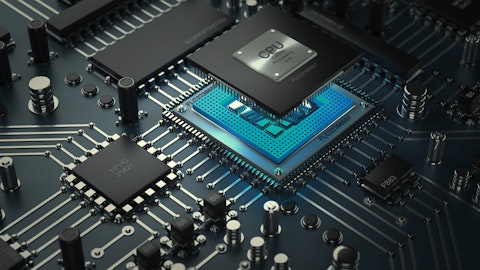Microchip Technology Incorporated (NASDAQ:MCHP) Q2 2024 Earnings Call Transcript November 2, 2023
Microchip Technology Incorporated misses on earnings expectations. Reported EPS is $1.21 EPS, expectations were $1.62.
Operator: Greetings and welcome to the Microchip Technology Q2 Fiscal Year 2024 Financial Results Conference Call. [Operator Instructions] As a reminder, this conference is being recorded. I would now like to turn the conference over to your host, Eric Bjornholt, Chief Financial Officer.
Eric Bjornholt: Good afternoon, everybody. During the course of this conference call, we will be making projections and other forward-looking statements regarding future events or the future financial performance of the company. We wish to caution you that such statements are predictions and that actual events or results may differ materially. We refer you to our press release as of today as well as our recent filings with the SEC that identify important risk factors that may impact Microchip’s business and results of operations. In attendance with me today are Ganesh Moorthy, Microchip’s President and CEO and Steve Sanghi, Microchip’s Executive Chair; and Sajid Daudi, Microchip’s Head of Investor Relations. I will comment on our second quarter fiscal year 2024 financial performance.
Ganesh will then provide commentary on our results and discuss the current business environment as well as our guidance. And Steve will provide an update on our cash return strategy. We will then be available to respond to specific investor and analyst questions. We are including information in our press release and this conference call on various GAAP and non-GAAP measures. We have posted a full GAAP to non-GAAP reconciliation on the Investor Relations page of our website at www.microchip.com and included reconciliation information in our earnings press release which we believe you will find useful when comparing GAAP and non-GAAP results. We have also posted a summary of our outstanding debt and our leverage metrics on our website. I will now go through some of the operating results, including net sales, gross margin and operating expenses.
Other than net sales, I will be referring to these results on a non-GAAP basis which is based on expenses prior to the effects of our acquisition activities, share-based compensation and certain other adjustments as described in our earnings press release and the reconciliations on our website. Net sales in the September quarter were $2.254 billion which were down 1.5% sequentially. We have posted a summary of our net sales by product line and geography on our website for your reference. On a non-GAAP basis, gross margins were 68.1%, operating expenses were at 20% and operating income was a record 48.1%. Non-GAAP net income was $889.3 million and non-GAAP earnings per diluted share was $1.62. On a GAAP basis in the September quarter, gross margins were 67.8%, total operating expenses were $642.4 million and included acquisition intangible amortization of $151.4 million, special charges of $1.8 million, share-based compensation of $38 million and $1.1 million of other expenses.
GAAP net income was a record $666.6 million, resulting in a record $1.21 in earnings per diluted share. Our non-GAAP cash tax rate was 14.2% in the September quarter. Our non-GAAP tax rate for fiscal year 2024 is expected to be about 14.2% which is exclusive of the transition tax and any tax audit settlements related to taxes accrued in prior fiscal years. Our fiscal ’24 cash tax rate is expected to be higher than our fiscal ’23 tax rate for a variety of factors, including lower availability of tax attributes, such as net operating losses and tax credits, lower depreciation with our expectation for lower capital expenditures in the U.S. in fiscal ’24, as well as the impact of current tax rules requiring the capitalization of R&D expenses for tax purposes.
We are still hopeful that the tax rules requiring companies to capitalize R&D expenses will be pushed out or repeal. If this were to happen, we would anticipate about a 200 basis point favorable adjustment to Microchip’s non-GAAP tax rate in future periods. Our inventory balance at September 30, 2023, was $1.331 billion. We had 167 days of inventory at the end of the September quarter which was flat to the prior quarter’s level. Although we reduced inventory dollars in the quarter, we were not able to make as much progress as we would have liked, as we continue to accommodate requests by customers to push out delivery schedules for products that were very far through the manufacturing process. We also continue to invest in building inventory for long-lived, high-margin products whose manufacturing capacity is being end of life by our supply chain partners and these last-time buys represented 10 days of inventory at the end of September.
We expect dollars of inventory on our balance sheet to reduce in the December quarter. Inventory at our distributors in the September quarter was at 35 days which was up 6 days from the prior quarter’s level. Our cash flow from operating activities was $616.2 million in the September quarter. Included in our cash flow from operating activities was $87.5 million of long-term supply assurance receipts from customers. We have adjusted these items out of our free cash flow to determine the adjusted free cash flow that we will return to shareholders through dividends and share repurchases, as these supply assurance payments will be refundable over time as purchase commitments are fulfilled. Our adjusted free cash flow was $454.3 million in the September quarter.
As of September 30, our consolidated cash and total investment position was $256.6 million. Our total debt increased by $45.6 million in the September quarter and our net debt was up by $60.2 million. Over the last 21 full quarters since we closed the Microsemi [ph] acquisition and incurred over $8 billion in debt to do so, we have paid down $6.72 billion of the debt and continue to allocate substantially all of our excess cash beyond dividends and stock buyback to bring down this debt. In the September quarter, we issued a $750 million Term Loan A and retired $1 billion in bonds that matured on September 1, 2023, with the Term Loan A and proceeds from our line of credit. We also issued $1 billion of commercial paper during the September quarter, taking advantage of about a 90 basis point lower interest rate on the commercial paper compared to our line of credit rate.
Our line of credit had $39 million of borrowings against it at September 30, 2023. During the September quarter, we also retired $18.2 million of total principal amount of our 2027 convertible bonds for a total cash payment of $42.7 million. The amount paid above the principal amount essentially works like a synthetic stock buyback, reducing any current and future share count dilution that could result if these convertible bonds were ever converted into shares. The $24.5 million we paid above the par value for the convertible bonds was in addition to our normal share buyback activity that we executed during the quarter, resulting in an additional reduction in the diluted share count outstanding. Our adjusted EBITDA in the September quarter was $1.152 billion and 51.1% of net sales.
Our trailing 12-month adjusted EBITDA was a record at $4.57 billion. Our net debt to adjusted EBITDA was 1.28 at September 30, 2023, down from 1.84 at September 30, 2022. Capital expenditures were $74.4 million in the September quarter. Our expectation for capital expenditures for fiscal year 2024 is between $300 million and $325 million which is down from the $300 million to $350 million we shared with investors last quarter, as we are delaying certain capital given the more challenging economic backdrop. We expect that our capital investments will continue to provide us with increased control over our production during periods of industry-wide constraints. Depreciation expense in the September quarter was $47 million. I will now turn it over to Ganesh to give his comments on the performance of the business in the September quarter as well as our guidance for the December quarter.
Ganesh?

Ganesh Moorthy: Thank you, Eric and good afternoon, everyone. Our September quarter results were about as we expected, with net sales coming in just under the midpoint of our guidance and well within our guidance range. Net sales were down 1.5% sequentially and up 8.7% on a year-over-year basis. Non-GAAP gross and operating margins remained strong at 68.1% and 48.1%, respectively. Our consolidated non-GAAP diluted EPS was at the midpoint of our guidance at $1.62 per share, up 11% from the year ago quarter. Adjusted EBITDA was 51.1% of net sales and adjusted free cash flow was 20.2% of net sales in the September quarter, continuing to demonstrate the strong cash generation characteristics of our business. Our net leverage exiting September dropped to 1.28x.
We had higher cash flow outflows in the September quarter compared to the June quarter, due to the timing of tax payments and because of record capital return to shareholders in dividends and share repurchases totaling $562.6 million. This is 61% higher than the capital returned to shareholders in the June quarter. Our capital return to shareholders in the December quarter will increase to 77.5% of our September quarter adjusted free cash flow. As we continue on our path, [indiscernible] down 100% of our adjusted free cash flow to shareholders by the March quarter calendar year 2025. My thanks to all our stakeholders, who enabled us to achieve these results despite the increasingly challenging macro environment and especially to the worldwide Microchip team, whose effort and engagement enables us to navigate effectively through the business cycles.
Taking a look at our September 1st quarter net sales from a product line and geographic perspective. Our mixed signal Microcontroller [ph] net sales were down 1.7% sequentially and up 8.5% on a year-over-year basis. Our Analog product line, net sales were down 1.7% sequentially and up 8.8% on a year-over-year basis. On a sequential revenue basis, Asia was down, Europe was about flat and the Americas was slightly up. Now for some color on the September quarter. Our business slowed down as expected, as our customers continue to respond to the effects of increasing business uncertainty, slowing economic activity and a result in increase in inventory. The combined effects of persistent inflation and high interest rates, we believe, are contributing to the weak macro environment.
All regions of the world and most end markets experienced varying degrees of weakness. We continue to receive requests to push out or cancel backlog, as customers start to rebalance their inventory in light of the weaker business conditions and increased uncertainty they were experiencing. And we were able to push out meaningful amounts of backlog to later quarters to help many customers with inventory positions. We are seeing customers continue to adjust the demand expectations as they derisk the inventory position whenever possible. Our experience from prior cycles is that at this stage of the cycle, customers tend to overcorrect their inventory and backlog due to their business uncertainty, combined with the availability of product with very short lead times.
This is, in effect, the flip side of what we saw during 2021 and 2022, when demand was historically strong and seemingly insatiable. Reflecting the slow macro environment, our channel inventory grew 235 days [ph]. We are working with our channel partners to find the right balance of inventory required to serve customers, as well as to be positioned for the eventual strengthening of business conditions. Most of our internal capacity expansion actions remain paused and we expect this will result in lower capital investments in fiscal year ’24 and fiscal year ’25, even as we prepare for the expected robust long-term growth of our business. In the meanwhile, we have been driving our lead times down and have reduced average lead times from approximately 52 weeks at the start of 2023 to approximately 26 weeks at the end of June and exited the September quarter at approximately 13 weeks.
We expect to continue to drive average lead times down further, to less than 8 weeks by the end of 2023. During a period of macro weakness and business uncertainty, we believe short lead times are the best way to help customers navigate the environment successfully and improve the quality of backlog placed on us, as it enables our customers and Microchip to engage an uncertain environment with more agility and effectiveness. However, the significant reduction in lead times is also resulting in lower bookings and reduced near-term visibility. Now let’s get into the guidance for the December quarter. As our customers take further actions to adjust to a weakening macro environment and uncertain business conditions, we are continuing to support customers and channel partners with inventory positions to push out their backlog.
Taking all the factors we have discussed on the call today into consideration, we expect our net sales for the December quarter to be between down 15% and down 20% sequentially. At the midpoint of our net sales guidance for the December quarter, our year-over-year decline for the quarter would be 14.3%. We expect our non-GAAP gross margin to be between 64% and 65% of sales. We expect non-GAAP operating expenses to be between 22.7% and 23.3% of sales. We expect non-GAAP operating profit to be between 40.7% and 42.3% of sales and we expect our non-GAAP diluted earnings per share to be between $1.09 and $1.17 per share. Given the current macro weakness and resultant business uncertainty, combined with our lower bookings and reduce near-term visibility, we anticipate that our March quarter revenue is likely to decline again sequentially, although to a lesser extent than the December quarter decline.
Notwithstanding any near-term macro weakness, we are confident that semiconductors remain the engine of innovation for the applications and markets we serve. Our focus on total system solutions and key market megatrends is fueling strong design win momentum that we expect will drive above-market long-term growth. If you review Microchip’s speak to crop performance on a trailing 12-month basis, through the business cycles over the last 15-plus years which is included in the investor presentation posted on our website, you will observe our consistent and resilient cash generation gross margin and operating margin results. We remain confident that our non-GAAP operating margins on a trailing 12-month basis should remain above 40% through the business cycles.
With that, let me pass the baton to Steve to talk more about our cash return to shareholders.
Steve Sanghi: Thank you, Ganesh and good afternoon, everyone. I would like to provide you with a further update on our cash return strategy. The Board of Directors announced an increase in the dividend of 33.8% from the year ago quarter to $0.439 per share. During the last quarter, we purchased $339.8 million of our stock in the open market. We also paid out $222.8 million in dividends. Thus, the total cash return was a record $562.6 million. This amount was 72.5% of our actual adjusted free cash flow of $776 million during the June 2023 quarter. Our net leverage at the end of September 2023 quarter was 1.28x. Ever since we achieved an investment-grade rating for our debt in November 2021 and pivoted to increasing our capital return to shareholders, we have returned $3.248 billion to shareholders in September 30, 2023, by a combination of dividends and buybacks.
In the current December quarter, we will use the adjusted free cash flow from the September quarter to target the amount of cash returned to shareholders. The adjusted free cash flow excludes a net $87.5 million that we collected from our customers for long-term supply assurance payments. These payments are refundable when first two commitments are fulfilled. The adjusted free cash flow for the September quarter was $454.3 million [ph]. We plan to return 77.5% or $352.1 million of that amount to our shareholders with the dividend expected to be approximately $237.5 million and the stock buyback expected to be approximately $114.6 million. Going forward, we plan to continue to increase free cash flow return to shareholders by 500 basis points every quarter until we reach 100% of adjusted free cash flow returned to shareholders.
That will take 5 more quarters and dividends over time, we expect will represent approximately 50% of our cash returned. With that, operator, will you please poll for questions?
See also 12 Countries with Most Prisoners Per Capita and 30 Most Barbaric Countries in the World.
Q&A Session
Follow Microchip Technology Inc (NASDAQ:MCHP)
Follow Microchip Technology Inc (NASDAQ:MCHP)
Operator: [Operator Instructions] First question comes from the line of Toshiya Hari with Goldman Sachs.
Toshiya Hari: I guess my first question is on the December quarter outlook. I think you gave a little bit of color by GEO but I was hoping you could provide a little bit of context by end market, if any of the end markets stand out [indiscernible] the downside or the upside? And is this mostly volume that’s driving the sequential decline in revenue? Or are you starting to see pricing erode a little bit as well?
Ganesh Moorthy: Sure. So firstly, there is no pricing that is driving the changes. It’s all volume. The weakness is very broad-based across the different geographies, across the different end markets, with perhaps the one end market which continues to have reasonable resilience is aerospace and defense, as you might expect. But it’s extremely broad-based at this point.
Toshiya Hari: Got it. And then as my follow-up, maybe one for Eric on gross margin and I guess, utilization rates as well. How are your factories running today, both wafer processing and packaging and test? And as you continue to adjust to evolving demand environment, how should we see that impacting gross margins beyond the December quarter? How should we think about the trough?
Eric Bjornholt: Okay. So on utilization, we have left the wafer fabs kind of reduced from where they were at the peak when they were running just full out and that has dropped modestly. We’re still not in a situation where we are taking underutilization charges and that’s not anticipated in the gross margin guidance that we’ve provided but they are running at lower levels and not as efficiently. On the assembly and test side, we definitely have reduced the activities in assembly and tests. We’d rather build the product through Dibang [ph] through the wafer fab and then have it ready when orders come in to be able to turn it quite quickly with short lead times to the assembly and test process. So the assembly and test is more kind of in line with where consumption is. We actually reduced finished goods last quarter and we’ll continue to be very focused on that.
Operator: And our next question comes from the line of Ambrish Srivastava with BMO.
Ambrish Srivastava: Ganesh, you mentioned cancellations in your prepared remarks and I just wanted to get — if you could provide us with a little bit more details around that. This is the first time you mentioned that. And so what percentage is it of your orders. And then for you, is just starting the year-over-year decline which is kind of a related second part question is the typical cycle, I don’t know, 5 to 7 quarters, year-over-year decline. What’s your sense of how long does the year-over-year decline last, given the programs you have in place. Now if you look back, clearly, you were over shipping over the last few quarters. So color on both would be very helpful.
Ganesh Moorthy: So first of all, inside of 90 days, any orders that a customer has are cancelable. So that’s our just standard tires. And then there are the longer-term non-cancelable orders that we have worked and we don’t really work on cancellations there as much as rescheduling and pushing out where that backlog would be. A lot of the backlog that has been placed over the last many quarters were based on very long lead times and the conditions for the market for many of our customers have changed over that time. And so what they believe their businesses are going to do and what their businesses are doing today are a little bit different from when they place those orders. And that’s where they’re making adjustments to what they require.
And if their run rates come down, then whatever units they have in inventory or they have placed on us are at a higher run rate than they really need. And that’s what reflects some of the correction you’re seeing to bring our shipments and the customer’s inventory more on the line.
Ambrish Srivastava: And then the period of year-over-year declines on a — if you just compare it to the last few cycles?
Ganesh Moorthy: Every cycle is different. I don’t know about the year-over-year decline necessarily. But when you look at historically how cycles have played out. Typically, there’s a 2-quarter, 3-quarter period of time over which the digestion of that inventory takes place. And upon that being completed, the consumption which is normally ahead of the shipments catch it back up and that’s how the cycle gets reborn in what we have seen.
Operator: Our next question comes from the line of Gary Mobley with Wells Fargo.
Gary Mobley: You commented in your prepared remarks that you expect a further sequential decrease in the March quarter. And I would assume that, that would come with perhaps some lower gross margin attached to it. And that puts you pretty close to that 40% op margin threshold without any OpEx adjustments. So maybe you can just speak to whether or not that lower revenue comes with lower gross margin. And as well, what sort of measures you’d be willing to take to make OpEx adjustments.
Ganesh Moorthy: So I think in any given quarter, as revenue declines, the operating margin had a very large change in revenue. It’s not — you can’t draw a line and say, it will never fall below this line. We look at our operating margins on a trailing 12-month basis. That’s what we’ve always had in terms of the data we’ve presented, the truck numbers that we have put out there. And we don’t know exactly what the magnitude of what might take place in March is. But we’re confident that if you look at a 4-quarter rolling or trailing 12 months, we will still be at that 40% trough as where we see it going.
Eric Bjornholt: I guess I would add to that is what investors and analysts have seen from Microchip over time when we face these cycles is we are pretty nimble and we adjust our business appropriately to the environment, whether that’s on the expense side or if we need to do something with utilization. And right now, we’re continuing to run the factories at a pretty high level but lower than they were before. And OpEx, we have some weathers that we can pull depending on what business environment we’re going to be facing in March and beyond.
Gary Mobley: Okay. And the follow-up I want to ask about distribution inventory which was up sequentially. I know you don’t really have a sense of how quickly they think is draining or the channel is draining [ph]. But maybe if you could just give us a sense of when you could get — see that work down a bit?




